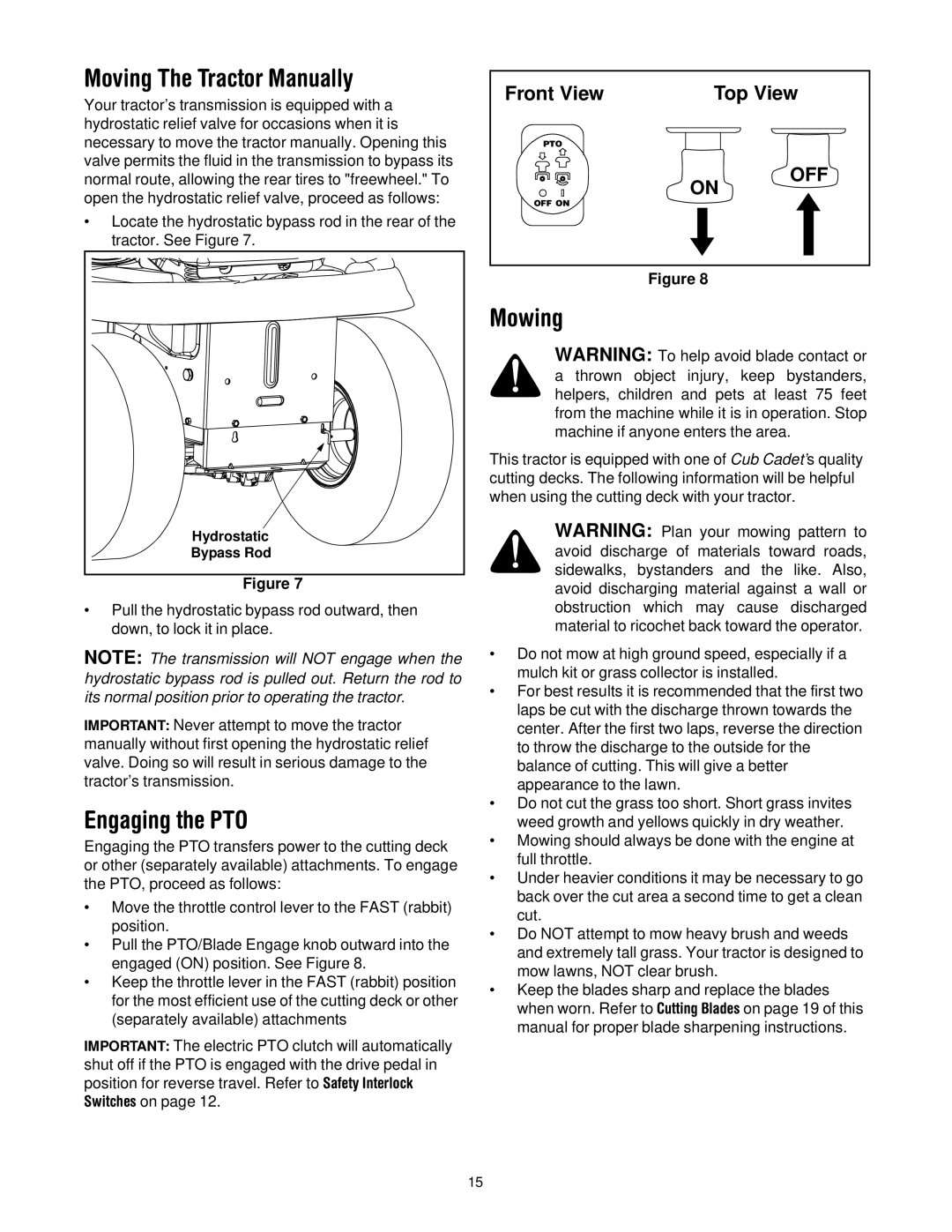
Moving The Tractor Manually
Your tractor’s transmission is equipped with a hydrostatic relief valve for occasions when it is necessary to move the tractor manually. Opening this valve permits the fluid in the transmission to bypass its normal route, allowing the rear tires to "freewheel." To open the hydrostatic relief valve, proceed as follows:
•Locate the hydrostatic bypass rod in the rear of the tractor. See Figure 7.
Hydrostatic |
Bypass Rod |
Figure 7
•Pull the hydrostatic bypass rod outward, then down, to lock it in place.
NOTE: The transmission will NOT engage when the hydrostatic bypass rod is pulled out. Return the rod to its normal position prior to operating the tractor.
IMPORTANT: Never attempt to move the tractor manually without first opening the hydrostatic relief valve. Doing so will result in serious damage to the tractor’s transmission.
Engaging the PTO
Engaging the PTO transfers power to the cutting deck or other (separately available) attachments. To engage the PTO, proceed as follows:
•Move the throttle control lever to the FAST (rabbit) position.
•Pull the PTO/Blade Engage knob outward into the engaged (ON) position. See Figure 8.
•Keep the throttle lever in the FAST (rabbit) position for the most efficient use of the cutting deck or other (separately available) attachments
IMPORTANT: The electric PTO clutch will automatically shut off if the PTO is engaged with the drive pedal in position for reverse travel. Refer to Safety Interlock Switches on page 12.
Front View | Top View |
PTO |
|
| OFF |
OFF ON | ON |
|
Figure 8
Mowing
WARNING: To help avoid blade contact or a thrown object injury, keep bystanders, helpers, children and pets at least 75 feet from the machine while it is in operation. Stop machine if anyone enters the area.
This tractor is equipped with one of Cub Cadet’s quality cutting decks. The following information will be helpful when using the cutting deck with your tractor.
WARNING: Plan your mowing pattern to avoid discharge of materials toward roads, sidewalks, bystanders and the like. Also, avoid discharging material against a wall or obstruction which may cause discharged material to ricochet back toward the operator.
•Do not mow at high ground speed, especially if a mulch kit or grass collector is installed.
•For best results it is recommended that the first two laps be cut with the discharge thrown towards the center. After the first two laps, reverse the direction to throw the discharge to the outside for the balance of cutting. This will give a better appearance to the lawn.
•Do not cut the grass too short. Short grass invites weed growth and yellows quickly in dry weather.
•Mowing should always be done with the engine at full throttle.
•Under heavier conditions it may be necessary to go back over the cut area a second time to get a clean cut.
•Do NOT attempt to mow heavy brush and weeds and extremely tall grass. Your tractor is designed to mow lawns, NOT clear brush.
•Keep the blades sharp and replace the blades when worn. Refer to Cutting Blades on page 19 of this manual for proper blade sharpening instructions.
15
